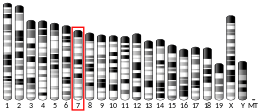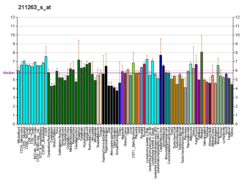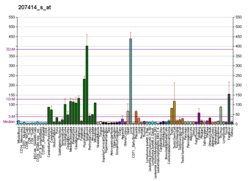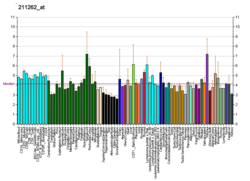PCSK6
Proprotein convertase subtilisin/kexin type 6 is an protease that in humans is encoded by the PCSK6 gene which is located in chromosome 15.[5][6] Pcsk6 is a calcium-dependent serine endoprotease that catalyzes the post-translational modification of precursor proteins from its ‘latent’ form to the cleaved ‘active’ form.[5] Active Pcsk6 has been reported to process substrates such as transforming growth factor β,[7] pro-albumin,[8] von Willebrand factor,[9] and corin.[10] Clinically, Pcsk6 is suggested to play a role in left/right asymmetry,[11] structural asymmetry of the brain,[12] handedness,[13][14][15] tumor progression,[16] hemostasis,[9][8][7] and cardiovascular diseases.[10][17]
Function
The protein encoded by this gene belongs to the subtilisin-like proprotein convertase family. The members of this family are proprotein convertases that process latent precursor proteins into their biologically active products. This encoded protein is a calcium-dependent serine endoprotease that can cleave precursor protein at their paired basic amino acid processing sites. Some of its substrates are - transforming growth factor beta related proteins,[7] pro-albumin,[8] von Willebrand factor,[9] and corin.[10] Alternatively spliced transcript variants encoding different isoforms have been identified.[6]
Clinical significance
During development: Throughout development, the spatial and temporal expression of pcsk6 regulates embryogenesis by activating TGFβ related differentiation factors, which include BMP and Nodal.[7][18] Elevated levels of Pcsk6 was detected in maternal decidual cells of the implantation site and the extraembryonic ectoderm.[19] The regulation of proper gradient of Nodal and BMPs is crucial for gastrulation,[20] proximal-distal axis,[21] and establishment of left-right axis patterning.[22]
Developmental Pcsk6 knockout studies found that mice embryos that lack Pcsk6 develop heterotaxia, left pulmonary isomerism, and/or craniofacial malformations due to disruption in specification of anterior-posterior and left-right axis that resulted from the dysregulation of Nodal and BMP signaling.[11]
In humans, Pcsk6 VNTR polymorphism is associated with the structural asymmetry of the frontal and temporal lobe,[12] and degree of handedness.[13][14]
Cardiovascular disease: Pcsk6 is increasing interest as indicator and factor of cardiovascular disease. Pcsk6 KO mice was shown to develop salt-sensitive hypertension due to failure of pro-corin activation crucial to atrial natriuretic peptide regulation of blood pressure.[10] A hypertensive patient was found to have a G/A mutation on the PCSK6 gene that resulted in a Asp282Asn (D282N) substitution at the Pcsk6 catalytic domain, which in turn, hinders corin processing.[10] In vascular remodeling, Pcsk6 was found to induce smooth muscle cell migration in response to PDGFB by activating MMP14.[17] When Pcsk6 was knocked out, the intimal hyperplasia response to in vivo carotid ligation was lowered.[17]
Other: This gene is thought to play a role in tumor progression.[6][16]
References
- GRCh38: Ensembl release 89: ENSG00000140479 - Ensembl, May 2017
- GRCm38: Ensembl release 89: ENSMUSG00000030513 - Ensembl, May 2017
- "Human PubMed Reference:". National Center for Biotechnology Information, U.S. National Library of Medicine.
- "Mouse PubMed Reference:". National Center for Biotechnology Information, U.S. National Library of Medicine.
- KIEFER, MICHAEL C.; TUCKER, JEFFREY E.; JOH, RICHARD; LANDSBERG, KATHERINE E.; SALTMAN, DAVID; BARR, PHILIP J. (December 1991). "Identification of a Second Human Subtilisin-Like Protease Gene in the fes/fps Region of Chromosome 15". DNA and Cell Biology. 10 (10): 757–769. doi:10.1089/dna.1991.10.757. ISSN 1044-5498. PMID 1741956.
- "Entrez Gene: PCSK6 proprotein convertase subtilisin/kexin type 6".
- Constam, Daniel B. (August 2014). "Regulation of TGFβ and related signals by precursor processing". Seminars in Cell & Developmental Biology. 32: 85–97. doi:10.1016/j.semcdb.2014.01.008. ISSN 1084-9521. PMID 24508081.
- Mori, K.; Imamaki, A.; Nagata, K.; Yonetomi, Y.; Kiyokage-Yoshimoto, R.; Martin, T. J.; Gillespie, M. T.; Nagahama, M.; Tsuji, A.; Matsuda, Y. (1999-03-01). "Subtilisin-Like Proprotein Convertases, PACE4 and PC8, as Well as Furin, are Endogenous Proalbumin Convertases in HepG2 Cells". Journal of Biochemistry. 125 (3): 627–633. doi:10.1093/oxfordjournals.jbchem.a022329. ISSN 0021-924X. PMID 10050053.
- Rehemtulla, Alnawaz; Barr, Philip J.; Rhodes, Christopher J.; Kaufman, Randal J. (1993-01-26). "PACE4 is a member of the mammalian propeptidase family that has overlapping but not identical substrate specificity to PACE". Biochemistry. 32 (43): 11586–11590. doi:10.1021/bi00094a015. ISSN 0006-2960. PMID 8218226.
- Chen, Shenghan; Cao, Pengxiu; Dong, Ningzheng; Peng, Jianhao; Zhang, Chunyi; Wang, Hao; Zhou, Tiantian; Yang, Junhua; Zhang, Yue; Martelli, Elizabeth E; Naga Prasad, Sathyamangla V (2015-08-10). "PCSK6-mediated corin activation is essential for normal blood pressure". Nature Medicine. 21 (9): 1048–1053. doi:10.1038/nm.3920. ISSN 1078-8956. PMC 4710517. PMID 26259032.
- Constam, D. B.; Robertson, E. J. (2000-05-01). "SPC4/PACE4 regulates a TGFbeta signaling network during axis formation". Genes & Development. 14 (9): 1146–1155. ISSN 0890-9369. PMC 316583. PMID 10809672.
- Berretz, Gesa; Arning, Larissa; Gerding, Wanda M.; Friedrich, Patrick; Fraenz, Christoph; Schlüter, Caroline; Epplen, Jörg T.; Güntürkün, Onur; Beste, Christian; Genç, Erhan; Ocklenburg, Sebastian (2019-05-21). "Structural Asymmetry in the Frontal and Temporal Lobes Is Associated with PCSK6 VNTR Polymorphism". Molecular Neurobiology. 56 (11): 7765–7773. doi:10.1007/s12035-019-01646-1. ISSN 0893-7648. PMID 31115778.
- Robinson, Kelsey J.; Hurd, Peter L.; Read, Silven; Crespi, Bernard J. (April 2016). "The PCSK6 gene is associated with handedness, the autism spectrum, and magical ideation in a non-clinical population". Neuropsychologia. 84: 205–212. doi:10.1016/j.neuropsychologia.2016.02.020. ISSN 0028-3932. PMID 26921480.
- Arning, Larissa; Ocklenburg, Sebastian; Schulz, Stefanie; Ness, Vanessa; Gerding, Wanda M.; Hengstler, Jan G.; Falkenstein, Michael; Epplen, Jörg T.; Güntürkün, Onur; Beste, Christian (2013-06-27). "PCSK6 VNTR Polymorphism Is Associated with Degree of Handedness but Not Direction of Handedness". PLOS ONE. 8 (6): e67251. Bibcode:2013PLoSO...867251A. doi:10.1371/journal.pone.0067251. ISSN 1932-6203. PMC 3695088. PMID 23826248.
- Scerri, Thomas S.; Brandler, William M.; Paracchini, Silvia; Morris, Andrew P.; Ring, Susan M.; Richardson, Alex J.; Talcott, Joel B.; Stein, John; Monaco, Anthony P. (2010-11-04). "PCSK6 is associated with handedness in individuals with dyslexia". Human Molecular Genetics. 20 (3): 608–614. doi:10.1093/hmg/ddq475. ISSN 1460-2083. PMC 3016905. PMID 21051773.
- Bassi, Daniel E.; Mahloogi, Haleh; Klein-Szanto, Andrés J. P. (2000). "The Proprotein Convertases Furin and PACE4 Play a Significant Role in Tumor Progression". Molecular Carcinogenesis. 28 (2): 63–69. doi:10.1002/1098-2744(200006)28:2<63::aid-mc1>3.0.co;2-c. ISSN 0899-1987. PMID 10900462.
- Rykaczewska, Urszula; Suur, Bianca E.; Röhl, Samuel; Razuvaev, Anton; Lengquist, Mariette; Sabater-Lleal, Maria; van der Laan, Sander W.; Miller, Clint L.; Wirka, Robert C.; Kronqvist, Malin; Gonzalez Diez, Maria (2020-02-28). "PCSK6 Is a Key Protease in the Control of Smooth Muscle Cell Function in Vascular Remodeling". Circulation Research. 126 (5): 571–585. doi:10.1161/circresaha.119.316063. ISSN 0009-7330. PMID 31893970.
- Constam, Daniel B.; Robertson, Elizabeth J. (1999-01-11). "Regulation of Bone Morphogenetic Protein Activity by Pro Domains and Proprotein Convertases". Journal of Cell Biology. 144 (1): 139–149. doi:10.1083/jcb.144.1.139. ISSN 0021-9525. PMC 2148113. PMID 9885250.
- Constam, D B; Calfon, M; Robertson, E J (1996-07-01). "SPC4, SPC6, and the novel protease SPC7 are coexpressed with bone morphogenetic proteins at distinct sites during embryogenesis". The Journal of Cell Biology. 134 (1): 181–191. doi:10.1083/jcb.134.1.181. ISSN 0021-9525. PMC 2120924. PMID 8698813.
- Mesnard, D. (2006-05-25). "Nodal specifies embryonic visceral endoderm and sustains pluripotent cells in the epiblast before overt axial patterning". Development. 133 (13): 2497–505. doi:10.1242/dev.02413. ISSN 0950-1991. PMID 16728477.
- Arnold, Sebastian J.; Robertson, Elizabeth J. (2009-01-08). "Making a commitment: cell lineage allocation and axis patterning in the early mouse embryo". Nature Reviews Molecular Cell Biology. 10 (2): 91–103. doi:10.1038/nrm2618. ISSN 1471-0072. PMID 19129791.
- Brennan, J. (2002-09-15). "Nodal activity in the node governs left-right asymmetry". Genes & Development. 16 (18): 2339–2344. doi:10.1101/gad.1016202. ISSN 0890-9369. PMC 187443. PMID 12231623.
Further reading
- Shore R, Covill L, Pettigrew KA, Diaz R, Xu Y, Tello J, Talcott J, Newbury D, Stein J, Monaco A (2016). "The handedness-associated PCSK6 locus spans an intronic promoter regulating novel transcripts". Hum Mol Genet. 25 (9): 1771–1779. doi:10.1093/hmg/ddw047. PMC 4986331. PMID 26908617.
- Bassi DE, Mahloogi H, Klein-Szanto AJ (2000). "The proprotein convertases furin and PACE4 play a significant role in tumor progression". Mol. Carcinog. 28 (2): 63–9. doi:10.1002/1098-2744(200006)28:2<63::AID-MC1>3.0.CO;2-C. PMID 10900462.
- Moulard M, Decroly E (2001). "Maturation of HIV envelope glycoprotein precursors by cellular endoproteases". Biochim. Biophys. Acta. 1469 (3): 121–32. doi:10.1016/S0304-4157(00)00014-9. PMID 11063880.
- Seidah NG, Prat A (2003). "Precursor convertases in the secretory pathway, cytosol and extracellular milieu". Essays Biochem. 38: 79–94. doi:10.1042/bse0380079. PMID 12463163.
- Tsuji A, Higashine K, Hine C, Mori K, Tamai Y, Nagamune H, Matsuda Y (1994). "Identification of novel cDNAs encoding human kexin-like protease, PACE4 isoforms". Biochem. Biophys. Res. Commun. 204 (3): 1381–2. doi:10.1006/bbrc.1994.2616. PMID 7980617.
- Tsuji A, Higashine K, Hine C, Mori K, Tamai Y, Nagamune H, Matsuda Y (1994). "Identification of novel cDNAs encoding human kexin-like protease, PACE4 isoforms". Biochem. Biophys. Res. Commun. 200 (2): 943–50. doi:10.1006/bbrc.1994.1541. PMID 8179631.
- Vollenweider F, Benjannet S, Decroly E, Savaria D, Lazure C, Thomas G, Chrétien M, Seidah NG (1996). "Comparative cellular processing of the human immunodeficiency virus (HIV-1) envelope glycoprotein gp160 by the mammalian subtilisin/kexin-like convertases". Biochem. J. 314 (Pt 2): 521–32. doi:10.1042/bj3140521. PMC 1217081. PMID 8670066.
- Zhong M, Benjannet S, Lazure C, Munzer S, Seidah NG (1997). "Functional analysis of human PACE4-A and PACE4-C isoforms: identification of a new PACE4-CS isoform". FEBS Lett. 396 (1): 31–6. doi:10.1016/0014-5793(96)01059-9. PMID 8906861.
- Decroly E, Wouters S, Di Bello C, Lazure C, Ruysschaert JM, Seidah NG (1997). "Identification of the paired basic convertases implicated in HIV gp160 processing based on in vitro assays and expression in CD4(+) cell lines". J. Biol. Chem. 271 (48): 30442–50. doi:10.1074/jbc.271.48.30442. PMID 8940009.
- Inocencio NM, Sucic JF, Moehring JM, Spence MJ, Moehring TJ (1997). "Endoprotease activities other than furin and PACE4 with a role in processing of HIV-I gp160 glycoproteins in CHO-K1 cells". J. Biol. Chem. 272 (2): 1344–8. doi:10.1074/jbc.272.2.1344. PMID 8995442.
- Mori K, Kii S, Tsuji A, Nagahama M, Imamaki A, Hayashi K, Akamatsu T, Nagamune H, Matsuda Y (1997). "A novel human PACE4 isoform, PACE4E is an active processing protease containing a hydrophobic cluster at the carboxy terminus". J. Biochem. 121 (5): 941–8. doi:10.1093/oxfordjournals.jbchem.a021677. PMID 9192737.
- Tsuji A, Hine C, Tamai Y, Yonemoto K, Mori K, Yoshida S, Bando M, Sakai E, Mori K, Akamatsu T, Matsuda Y (1997). "Genomic organization and alternative splicing of human PACE4 (SPC4), kexin-like processing endoprotease". J. Biochem. 122 (2): 438–52. doi:10.1093/oxfordjournals.jbchem.a021772. PMID 9378725.
- Moulard M, Chaloin L, Canarelli S, Mabrouk K, Darbon H, Challoin L (1998). "Retroviral envelope glycoprotein processing: structural investigation of the cleavage site". Biochemistry. 37 (13): 4510–7. doi:10.1021/bi972662f. PMID 9521771.
- Nagahama M, Taniguchi T, Hashimoto E, Imamaki A, Mori K, Tsuji A, Matsuda Y (1998). "Biosynthetic processing and quaternary interactions of proprotein convertase SPC4 (PACE4)". FEBS Lett. 434 (1–2): 155–9. doi:10.1016/S0014-5793(98)00970-3. PMID 9738469.
- Viale A, Ortola C, Hervieu G, Furuta M, Barbero P, Steiner DF, Seidah NG, Nahon JL (1999). "Cellular localization and role of prohormone convertases in the processing of pro-melanin concentrating hormone in mammals". J. Biol. Chem. 274 (10): 6536–45. doi:10.1074/jbc.274.10.6536. PMID 10037747.
- Mori K, Imamaki A, Nagata K, Yonetomi Y, Kiyokage-Yoshimoto R, Martin TJ, Gillespie MT, Nagahama M, Tsuji A, Matsuda Y (1999). "Subtilisin-like proprotein convertases, PACE4 and PC8, as well as furin, are endogenous proalbumin convertases in HepG2 cells". J. Biochem. 125 (3): 627–33. doi:10.1093/oxfordjournals.jbchem.a022329. PMID 10050053.
- Sucic JF, Moehring JM, Inocencio NM, Luchini JW, Moehring TJ (1999). "Endoprotease PACE4 is Ca2+-dependent and temperature-sensitive and can partly rescue the phenotype of a furin-deficient cell strain". Biochem. J. 339 (3): 639–47. doi:10.1042/0264-6021:3390639. PMC 1220200. PMID 10215603.
- Tsuji A, Yoshida S, Hasegawa S, Bando M, Yoshida I, Koide S, Mori K, Matsuda Y (2000). "Human subtilisin-like proprotein convertase, PACE4 (SPC4) gene expression is highly regulated through E-box elements in HepG2 and GH4C1 cells". J. Biochem. 126 (3): 494–502. doi:10.1093/oxfordjournals.jbchem.a022478. PMID 10467164.






